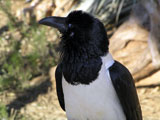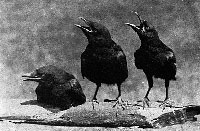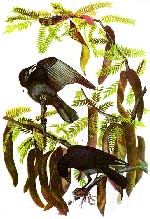|

 Size: Crows range in size from the relatively small pigeon-sized jackdaws
(Eurasian and Daurian) to the Common Raven of the Palearctic region
and Thick-billed Raven of the highlands of Ethiopia. Size: Crows range in size from the relatively small pigeon-sized jackdaws
(Eurasian and Daurian) to the Common Raven of the Palearctic region
and Thick-billed Raven of the highlands of Ethiopia.
Lurking in the Shadows: Many crow species are
all black. Most of their natural enemies,
the raptors or "falconiformes," soar high above the trees,
and hunt primarily on bright, sunny days when contrast between light
and shadow is greatest. Crows take advantage of this by maneuvering
themselves through the dappled shades of the trees, where their
black color renders them effectively invisible to their enemies
above, in order to set up complex ambush attacks. Thus, their black
coloring is of great strategic importance to their societies. It
is perhaps here where we find the greatest difference between ravens
and crows; ravens tend to soar high in the air as raptors do, and
like raptors, are usually the target of ambushes by crows. Crows
do not appear to perceive ravens as their own kind, but instead
treat them as raptors.

Not a Bird Brain: As a group, the crows show remarkable examples of intelligence.
They top the avian IQ scale. Crows and ravens often score very
highly on intelligence tests. Crows in the northwestern U.S. (a
blend of Corvus brachyrhynchos and Corvus caurinus) show modest
linguistic capabilities and the ability to relay information over
great distances, live in complex, hierarchic societies involving
hundreds of individuals with various "occupations," and
have an intense rivalry with the area's less socially advanced ravens.
One species, the New Caledonian Crow, has recently been intensively
studied because of its ability to manufacture and use its own tools
in the day-to-day search for food. Wild hooded crows in Israel have
learned to use bread crumbs for bait-fishing. Crows will engage
in a kind of air-jousting, or air-chicken to establish pecking order.
 Crow Calls: Crows make a wide variety of calls or vocalizations. Whether the
crows' system of communication constitutes a language is a topic
of debate and study. Crows have also been observed to respond to
calls of other species; this behaviour is presumably learned because
it varies regionally. Crows' vocalizations are complex and poorly
understood. One of the many vocalizations that crows make is a
"caw," sound, usually echoed back and forth between birds. They also utter a
series of "caws" in discrete units, counting out numbers,
a long caw followed by a series of short caws (usually made when
a bird takes off from a perch), an echo-like "eh-aw" sound,
and more. These vocalizations vary regionally. The pattern and number
of the numerical vocalizations have been observed to change in response
to events in the surroundings (i.e. arrival or departure of crows).
Crows can hear sound frequencies lower than those that humans can
hear, which complicates the study of their vocalizations. Crow Calls: Crows make a wide variety of calls or vocalizations. Whether the
crows' system of communication constitutes a language is a topic
of debate and study. Crows have also been observed to respond to
calls of other species; this behaviour is presumably learned because
it varies regionally. Crows' vocalizations are complex and poorly
understood. One of the many vocalizations that crows make is a
"caw," sound, usually echoed back and forth between birds. They also utter a
series of "caws" in discrete units, counting out numbers,
a long caw followed by a series of short caws (usually made when
a bird takes off from a perch), an echo-like "eh-aw" sound,
and more. These vocalizations vary regionally. The pattern and number
of the numerical vocalizations have been observed to change in response
to events in the surroundings (i.e. arrival or departure of crows).
Crows can hear sound frequencies lower than those that humans can
hear, which complicates the study of their vocalizations.

In literary and fanciful usage, the collective noun for a group
of crows is a murder. However, in practice most people, and especially
scientists, use the more generic term flock.
 Mythology and folklore: Crows, and especially ravens, often feature in legends or mythology as portents or harbingers of doom or death, because of their dark plumage, unnerving calls, and tendency to eat carrion. They are commonly thought to circle above scenes of death such as battles. Their depiction of evil has also led to some exaggeration of their appetite. In Pirates of the Caribbean: Dead Man's Chest and Exorcist: The Beginning, crows are shown tearing out people's eyes while they are still alive. This, of course, does not happen as crows can distinguish between carrion and living people. Mythology and folklore: Crows, and especially ravens, often feature in legends or mythology as portents or harbingers of doom or death, because of their dark plumage, unnerving calls, and tendency to eat carrion. They are commonly thought to circle above scenes of death such as battles. Their depiction of evil has also led to some exaggeration of their appetite. In Pirates of the Caribbean: Dead Man's Chest and Exorcist: The Beginning, crows are shown tearing out people's eyes while they are still alive. This, of course, does not happen as crows can distinguish between carrion and living people.
In Native American folklore, Crow is often seen as a similar trickster to Coyote. However, Crow's tricks tend to be more out of malice and they rarely (if ever) are portrayed as a hero. One possible explanation for this is that crows are often considered a pest to crops, which the tribes who came up with the stories featuring Crow needed to survive.
In the Epic of Gilgamesh, the Chaldean myth, the character Utnapishtim releases a dove and a raven to find land, similar to what Noah does in the book of Genesis. However, in the Epic of Gilgamesh, the dove merely circles and returns. Only then does Utnapishtim send forth the raven, who does not return. Utnapishtim extrapolates from this that the raven has found land, which is why it hasn't returned. This would seem to indicate some acknowledgement of crow intelligence, which may have been apparent even in ancient times, and to some might imply that the higher intelligence of crows, when compared to other birds, is striking enough that it was known even then.
Amongst Neopagans, crows are often thought to be highly psychic and are associated with the element of ether or spirit, rather than the element of air as with most other birds. This may in part be due to the long-standing occult tradition of associating the color black with "the abyss" of infinite knowledge (see akasha), or perhaps also to the more modern occult belief that wearing the "color" black aids in psychic ability, as it absorbs more electromagnetic energy, since surfaces appear black by absorbing all frequencies in the visible spectrum, reflecting no color.
In contrast with their association with death, in the 2004 computer game Half-Life 2, ravens represent hope amidst destruction, because the Combine Empire's takeover - and fascistic rule - of the Earth has caused so much destruction it's a wonder any of the Earth's native wildlife survived at all.
Gods and goddesses: A very incomplete list includes the eponymous Pacific Northwest Native figures Raven and Crow, the ravens Hugin and Munin, who accompany the Norse god Odin, the Celtic goddesses the Mórrígan and/or the Badb (sometimes considered separate from Mórrígan), and Shani, a Hindu god who travels astride a crow.
All text is available under the terms
of the GNU Free Documentation License
|